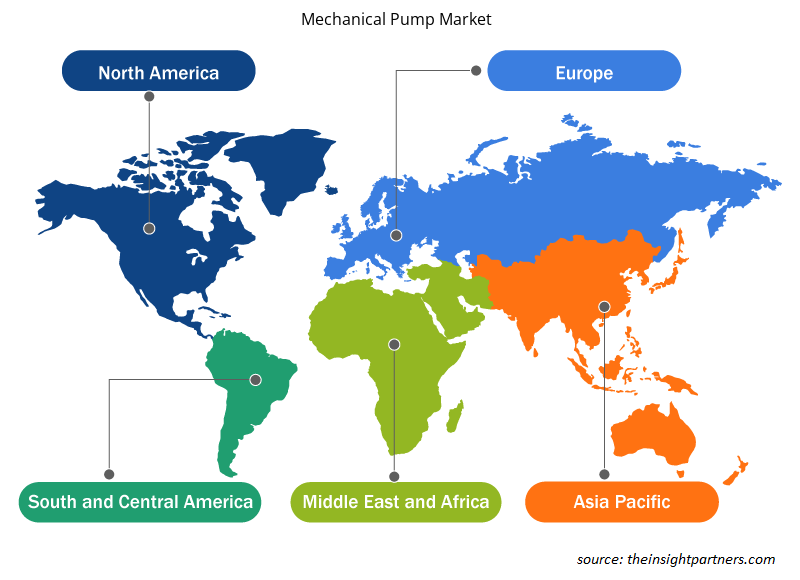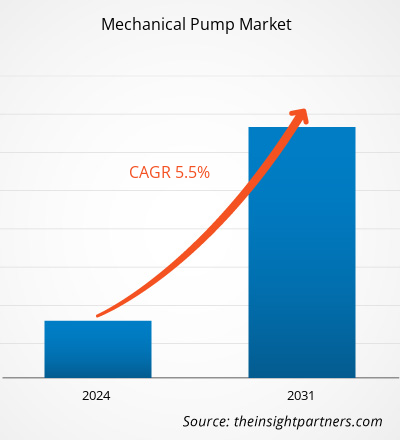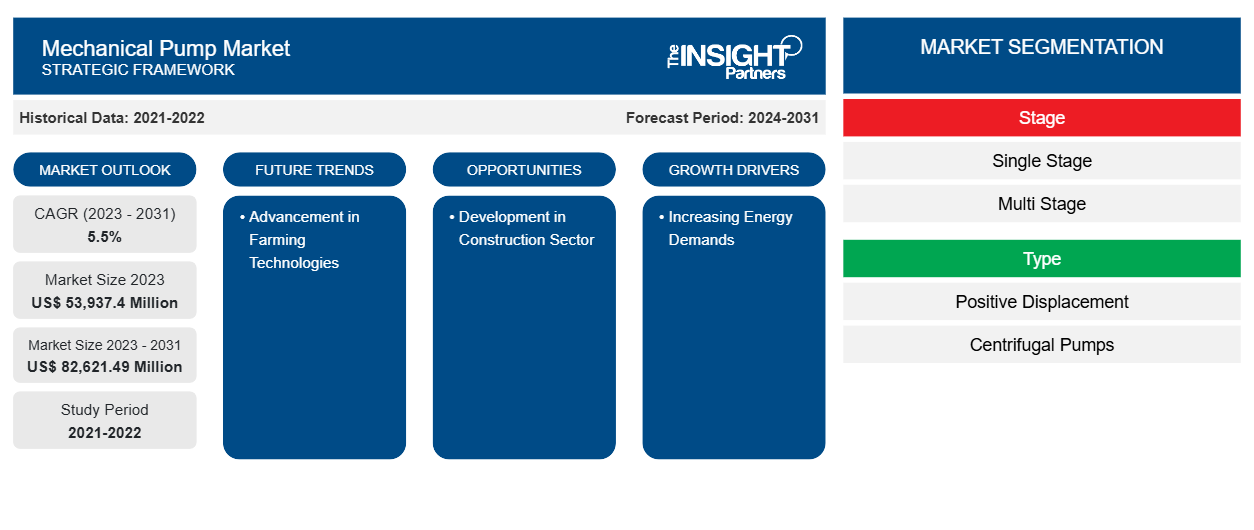Der Markt für mechanische Pumpen wird voraussichtlich von 53.937,4 Millionen US-Dollar im Jahr 2023 auf 82.621,49 Millionen US-Dollar im Jahr 2031 anwachsen. Der Markt wird im Zeitraum 2023–2031 voraussichtlich eine durchschnittliche jährliche Wachstumsrate von 5,5 % verzeichnen. Der wachsende Fortschritt in der Agrartechnologie wird wahrscheinlich ein wichtiger Trend auf dem Markt bleiben.
Marktanalyse für mechanische Pumpen
Zu diesen Interessenvertretern des Marktes für mechanische Pumpen zählen unter anderem Regierungsbehörden, Industrieverbände und Aufsichtsbehörden, wie etwa die Indian Pump Manufacturers' Association (IPMA), die British Pump Manufacturers' Association (BPMA), Europump (die europäische Vereinigung der Pumpenhersteller) und das Hydraulic Institute (HI). Zu den Endverbrauchern mechanischer Pumpen zählen unter anderem Branchen wie Chemie, Öl und Gas sowie Petrochemie, Bergbau, Stromerzeugung, Automobilindustrie, Landwirtschaft, Heizungs-, Lüftungs- und Klimatechnik und Abwassermanagement.
Marktübersicht für mechanische Pumpen
Zu den wichtigsten Akteuren im globalen Ökosystem des Marktes für mechanische Pumpen gehören Hersteller mechanischer Pumpen, Regierungsbehörden, Industrieverbände, Regulierungsbehörden, Lieferanten/Händler und Endverbraucher. Einige der wichtigsten Hersteller mechanischer Pumpen, die in diesem Bericht aufgeführt sind, sind Grundfos Holding A/S, Kirloskar Brothers Limited, KSB SE & Co. KGaA, Ebara Corporation, Sulzer Ltd, Pleuger Industries, The Weir Group PLC, Wilo SE, Tsurumi Manufacturing Co., Ltd. und Xylem Inc., um nur einige zu nennen. Neben diesen wichtigen Akteuren im Ökosystem spielen mehrere periphere Akteure im globalen Markt für mechanische Pumpen eine wichtige Rolle, um die Akzeptanz dieser Maschinen bei den Endverbrauchern zu ermöglichen und technologische Fortschritte für ein nachhaltiges zukünftiges Wachstum des Marktes zu fördern.
Passen Sie diesen Bericht Ihren Anforderungen an
Sie erhalten kostenlos individuelle Anpassungen an jedem Bericht, einschließlich Teilen dieses Berichts oder einer Analyse auf Länderebene, eines Excel-Datenpakets sowie tolle Angebote und Rabatte für Start-ups und Universitäten.
-
Holen Sie sich die wichtigsten Markttrends aus diesem Bericht.Dieses KOSTENLOSE Beispiel umfasst eine Datenanalyse von Markttrends bis hin zu Schätzungen und Prognosen.
Treiber und Chancen auf dem Markt für mechanische Pumpen
Steigender Energiebedarf der Marktteilnehmer begünstigt den Markt
Der wachsende Energiebedarf und die zunehmende Anforderung an eine unterbrechungsfreie Energieversorgung im gewerblichen und industriellen Sektor treiben den Bedarf an zusätzlicher Energieinfrastruktur voran. Wasser spielt bei der Stromerzeugung in diesen Anlagen eine Schlüsselrolle, da es in Dampf umgewandelt wird, um die Turbinen anzutreiben. In diesen Kraftwerken werden mechanische Pumpen zur Wasserzirkulation eingesetzt. Aufgrund der wachsenden Bevölkerung, Industrialisierung und Urbanisierung weltweit, insbesondere im asiatisch-pazifischen Raum, steigt der Energiebedarf rasant an. Infolgedessen werden weltweit mehrere Kraftwerke mit fossilen Brennstoffen eingesetzt. Darüber hinaus befindet sich die Stromerzeugung aus erneuerbaren Energiequellen in einem frühen Stadium und wird vor allem in Nordamerika und Europa betont. Der wachsende Energiebedarf und die damit einhergehende Steigerung der Stromerzeugungsaktivitäten kurbeln also das Wachstum des Marktes für mechanische Pumpen an.
Entwicklung im Bausektor
Mehrere ausländische Akteure verlagern ihre Produktionsstätten in Entwicklungsländer im asiatisch-pazifischen Raum, um von den niedrigen Arbeitskosten zu profitieren, was den industriellen Bau weiter vorantreiben soll. Angesichts der stetigen Zunahme der Bautätigkeiten weltweit wird erwartet, dass der Markt für mechanische Pumpen im Prognosezeitraum weiter wächst. Das Wachstum dieses Sektors ist hauptsächlich auf die zunehmende städtische Bevölkerung zurückzuführen, die durch einen Anstieg des Lebensstandards unterstützt wird. Auch der Anstieg des gewerblichen Baus, beispielsweise von Freizeitzentren, Kinosälen, Einkaufszentren, Krankenhäusern, Sportarenen und Bürogebäuden, treibt die Ausbreitung dieses Sektors weiter voran. Schwellenländer ergreifen verschiedene Initiativen, um die Industrialisierung voranzutreiben, indem sie günstige Geschäftsumgebungen für internationale Investoren schaffen und gleichzeitig das Wachstum der lokalen Fertigung unterstützen, was im Prognosezeitraum die Nachfrage nach mechanischen Pumpen ankurbeln soll.
Segmentierungsanalyse des Marktberichts für mechanische Pumpen
Wichtige Segmente, die zur Ableitung der Marktanalyse für mechanische Pumpen beigetragen haben, sind Stadium, Typ und Anwendung.
- Basierend auf der Stufe ist der Markt für mechanische Pumpen in einstufig und mehrstufig unterteilt. Das einstufige Segment hatte im Jahr 2023 einen größeren Marktanteil.
- Basierend auf dem Typ ist der Markt für mechanische Pumpen in Verdrängerpumpen und Kreiselpumpen unterteilt. Das Segment der Kreiselpumpen hatte im Jahr 2023 einen größeren Marktanteil.
- Basierend auf der Anwendung ist der Markt für mechanische Pumpen in Industrie-, Gewerbe- und Wohnpumpen unterteilt. Das Industriesegment hatte im Jahr 2023 einen größeren Marktanteil.
Marktanteilsanalyse für mechanische Pumpen nach Geografie
Der geografische Umfang des Marktberichts für mechanische Pumpen ist hauptsächlich in fünf Regionen unterteilt: Nordamerika, Asien-Pazifik, Europa, Naher Osten und Afrika sowie Süd- und Mittelamerika.
Der Umfang des Marktberichts für mechanische Pumpen umfasst Nordamerika (USA, Kanada und Mexiko), Europa (Russland, Großbritannien, Deutschland, Frankreich, Italien und den Rest Europas), den asiatisch-pazifischen Raum (Südkorea, Indien, Australien, Japan, China und den Rest des asiatisch-pazifischen Raums), den Nahen Osten und Afrika (Südafrika, Saudi-Arabien, die Vereinigten Arabischen Emirate und den Rest des Nahen Ostens und Afrikas) sowie Süd- und Mittelamerika (Argentinien, Brasilien und den Rest Süd- und Mittelamerikas). In Bezug auf den Umsatz dominierte der asiatisch-pazifische Raum im Jahr 2023 den Marktanteil mechanischer Pumpen. Nordamerika ist der zweitgrößte Beitragszahler zum globalen Markt für mechanische Pumpen, gefolgt von Europa.
Regionale Einblicke in den Markt für mechanische Pumpen
Die regionalen Trends und Faktoren, die den Markt für mechanische Pumpen im Prognosezeitraum beeinflussen, wurden von den Analysten von Insight Partners ausführlich erläutert. In diesem Abschnitt werden auch die Marktsegmente und die Geografie mechanischer Pumpen in Nordamerika, Europa, im asiatisch-pazifischen Raum, im Nahen Osten und Afrika sowie in Süd- und Mittelamerika erörtert.

- Erhalten Sie regionale Daten zum Markt für mechanische Pumpen
Umfang des Marktberichts über mechanische Pumpen
| Berichtsattribut | Details |
|---|---|
| Marktgröße im Jahr 2023 | 53.937,4 Millionen US-Dollar |
| Marktgröße bis 2031 | 82.621,49 Millionen US-Dollar |
| Globale CAGR (2023 - 2031) | 5,5 % |
| Historische Daten | 2021-2022 |
| Prognosezeitraum | 2024–2031 |
| Abgedeckte Segmente |
Nach Phase
|
| Abgedeckte Regionen und Länder |
Nordamerika
|
| Marktführer und wichtige Unternehmensprofile |
|
Dichte der Marktteilnehmer für mechanische Pumpen: Deren Auswirkungen auf die Geschäftsdynamik verstehen
Der Markt für mechanische Pumpen wächst rasant, angetrieben durch die steigende Nachfrage der Endnutzer aufgrund von Faktoren wie sich entwickelnden Verbraucherpräferenzen, technologischen Fortschritten und einem größeren Bewusstsein für die Vorteile des Produkts. Mit steigender Nachfrage erweitern Unternehmen ihr Angebot, entwickeln Innovationen, um die Bedürfnisse der Verbraucher zu erfüllen, und nutzen neue Trends, was das Marktwachstum weiter ankurbelt.
Die Marktteilnehmerdichte bezieht sich auf die Verteilung der Firmen oder Unternehmen, die in einem bestimmten Markt oder einer bestimmten Branche tätig sind. Sie gibt an, wie viele Wettbewerber (Marktteilnehmer) in einem bestimmten Marktraum im Verhältnis zu seiner Größe oder seinem gesamten Marktwert präsent sind.
Die wichtigsten auf dem Markt für mechanische Pumpen tätigen Unternehmen sind:
- EBARA CORPORATION
- Grundfos Holding A/S
- KIRLOSKAR BROTHERS LIMITED
- KSB SE & Co. KGaA
- PLEUGER INDUSTRIES
- Sulzer Ltd
Haftungsausschluss : Die oben aufgeführten Unternehmen sind nicht in einer bestimmten Reihenfolge aufgeführt.

- Überblick über die wichtigsten Akteure auf dem Markt für mechanische Pumpen
Neuigkeiten und aktuelle Entwicklungen auf dem Markt für mechanische Pumpen
Der Markt für mechanische Pumpen wird durch die Erhebung qualitativer und quantitativer Daten nach Primär- und Sekundärforschung bewertet, die wichtige Unternehmensveröffentlichungen, Verbandsdaten und Datenbanken umfasst. Nachfolgend sind einige der Entwicklungen auf dem Markt für mechanische Pumpen aufgeführt:
- EBARA Corporation Japan (EBARA) hat 100 % der Anteile an Hayward Gordon LP (Hayward Gordon) erworben. (Quelle: EBARA Corporation, Pressemitteilung, Oktober 2022)
- Grundfos Holding A/S, ein weltweit führender Anbieter fortschrittlicher Pumpenlösungen und Wassertechnologie, hat heute sein hochmodernes Werk in Serbien eingeweiht. (Quelle Grundfos Holding A/S, Pressemitteilung, September 2022)
Marktbericht zu mechanischen Pumpen – Abdeckung und Ergebnisse
Der Bericht „Marktgröße und Prognose für mechanische Pumpen (2021–2031)“ bietet eine detaillierte Analyse des Marktes, die die folgenden Bereiche abdeckt:
- Marktgröße und Prognose für mechanische Pumpen auf globaler, regionaler und Länderebene für alle wichtigen Marktsegmente, die im Rahmen des Berichts abgedeckt sind
- Markttrends für mechanische Pumpen sowie Marktdynamik wie Treiber, Einschränkungen und wichtige Chancen
- Detaillierte PEST- und SWOT-Analyse
- Marktanalyse für mechanische Pumpen, die wichtige Markttrends, globale und regionale Rahmenbedingungen, wichtige Akteure, Vorschriften und aktuelle Marktentwicklungen umfasst
- Branchenlandschaft und Wettbewerbsanalyse, die die Marktkonzentration, Heatmap-Analyse, prominente Akteure und aktuelle Entwicklungen für den Markt für mechanische Pumpen umfasst
- Detaillierte Firmenprofile
- Historische Analyse (2 Jahre), Basisjahr, Prognose (7 Jahre) mit CAGR
- PEST- und SWOT-Analyse
- Marktgröße Wert/Volumen – Global, Regional, Land
- Branchen- und Wettbewerbslandschaft
- Excel-Datensatz
Aktuelle Berichte
Verwandte Berichte
Erfahrungsberichte
Grund zum Kauf
- Fundierte Entscheidungsfindung
- Marktdynamik verstehen
- Wettbewerbsanalyse
- Kundeneinblicke
- Marktprognosen
- Risikominimierung
- Strategische Planung
- Investitionsbegründung
- Identifizierung neuer Märkte
- Verbesserung von Marketingstrategien
- Steigerung der Betriebseffizienz
- Anpassung an regulatorische Trends























 Kostenlose Probe anfordern für - Markt für mechanische Pumpen
Kostenlose Probe anfordern für - Markt für mechanische Pumpen